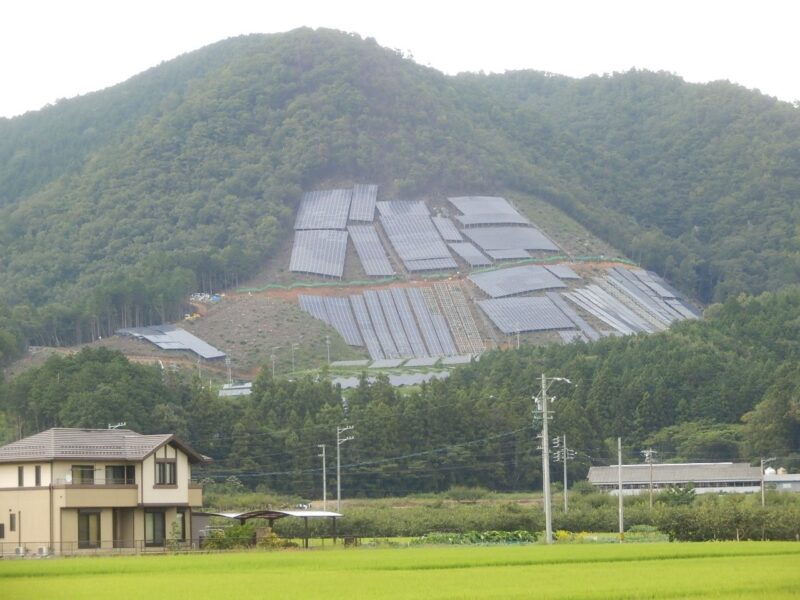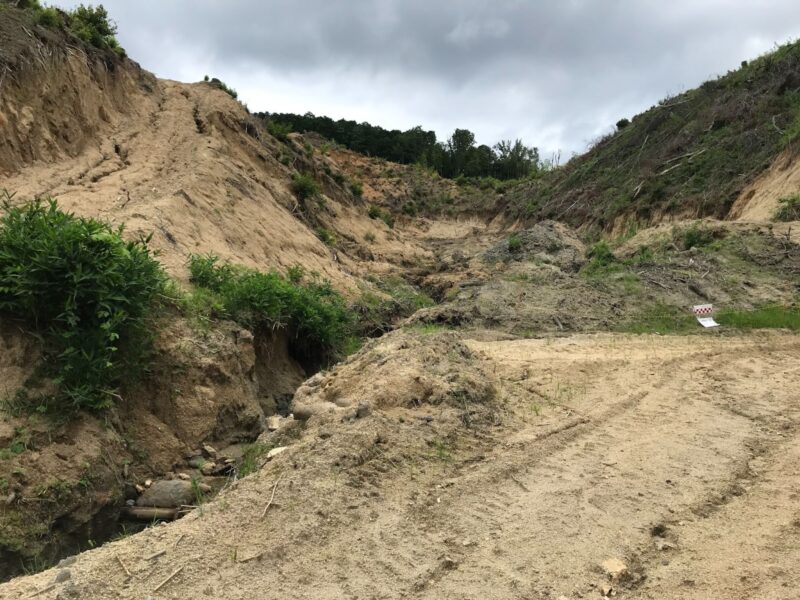Japan’s mega solar is causing some mega headaches
Originally published on Global Voices

A solar installation Awara, Fukui prefecture. Photo by Nevin Thompson. Image license: CC-BY-3.0
In a rush to slash carbon dioxide (C02) emissions and ditch its negative image of being overly reliant on fossil fuels, Japan has in recent years promoted solar power. However the “mega solar farms” that have been installed on mountainsides and in rural communities across the country often cause problems that harm the image of much-needed renewable energy projects.
By one estimate, there are over 6,000 mega solar farms operating throughout Japan. Mega solar farms are installations that produce over 1,000 kilowatts (1 megawatt) of energy each year — enough to power between 400 and 900 homes.
These mega solar farms have proliferated ever since the government introduced a Feed-in-Tariff (FIT) scheme to promote investment in renewable energy in 2012. Recent government policy continues to provide an encouraging environment for mega solar in Japan.
In 2020, then prime minister Suga Yoshihide pledged to make Japan carbon neutral by 2050. That same year, Koizumi Shinjirō, who was minister of the environment at the time, was so enamored with mega solar that he proposed revising laws to allow solar farms to be built in protected national park areas.
An example of the scale of these solar installations — and the scale of the problems they can create — can be found in Japan's Okayama prefecture, where one of the largest mega solar plants comprises 900,000 solar panels on 260 hectares of land, generating 230,000 kilowatts of energy each year.
Many residents who live near these installations say these mega solar farms destroy the environment and bring few benefits to the surrounding communities. Particularly worrisome are the landslides caused when mega solar farms are built on steep mountainside slopes.

Solar panels dominate a mountainside in Gifu, Gifu prefecture. Solar farms like this and even larger mega solar farms are causing many residents to worry about the danger of landslides. Photo by Magari Hiroyuki, 2017. Used with permission.
Opponents also cite the danger of solar panels being blown about in strong typhoons, potentially damaging electromagnetic fields emitted by solar power generation, as well as intense glare from the solar panels as reasons they are against mega solar.
Popular opposition appears to be so strong that a 2021 survey by the Mainichi Shimbun found that 80 percent of Japan’s 47 prefectures have problems with mega solar farms.
Part of the problem lies in Japan’s FIT system. Under the scheme, the Japanese government awards long-term contracts to renewable energy producers. However, many businesses and investors, who speculate on the buying and selling of FIT contracts, have viewed it simply as a money-making opportunity. The industry is so lucrative that big investors such as Goldman Sachs have set up a stock exchange for trading in Japanese solar projects.
The involvement of big firms and investors has meant that most locally-funded or smaller-scale solar projects have been cut out of the picture: 32 percent of all FIT contracts have gone to mega solar farms, and nearly 78 percent of these farms are financed with foreign or outside capital.
On top of this, the costs of funding the FIT system are passed on to taxpayers in the form of higher energy bills. As a result, electricity prices in Japan increased by 37 percent between 2011 and 2014.
In addition, much of the energy harvested from mega solar farms isn’t used locally; instead, it is consumed in distant urban areas. As a result, many of these communities are increasingly rejecting mega solar projects.
Residents of the small town of Heguri, in Nara prefecture, recently formed an opposition group and launched a lawsuit to stop a planned 48-hectare, 50,000-panel mega solar farm that was to be built in their community. They were especially concerned about landslides, environmental destruction, and the 22,000 volts of electromagnetic waves scheduled to pass directly under their town.
Some took to social media to express their frustration. One Twitter account, Heguri Middle School Students Opposed to the Mega Solar Project, said:
特別高圧線は半径2m以内に近づくだけで感電するって書いてある
こんなものを通学路1m下に埋めようとしているなんて、町・議員・事業者は鬼か何かですか?
そんなにまでしてメガソーラー設置したいの?設置すると何があるんですか?真実を教えて#メガソーラー建設反対 https://t.co/sbmVm37pIg
— 平群町中学生によるメガソーラー反対紛争記 (@hegurichomin) March 9, 2021
It says in this article [linked in the tweet] that one can receive an electric shock just by passing within two meters of extra-high voltage wires. But villainous town officials and builders are going to bury cables just one meter underneath a route that kids take to school.
Meanwhile, on the mountain climbing enthusiast site Yamap, one user, Yugo, documented and commented on the destruction and deforestation that had already occurred as a result of project construction.

An image from Yamap user, Yugo. “This place likely used to be a valley with rice fields,” Yugo commented after his tour of the area on July 18, 2021. Photo by Yugo. Used with permission
Approximately 1,000 residents took their opposition to the local district court by collecting over 9,000 signatures in support of scrapping the project. In response, the Nara prefectural government ordered the project to be halted in June 2021. The local government also found problems with the builder’s initial 2019 application and discovered that the project failed to meet proper safety regulations.
Now, the fate of the project remains in limbo. No construction has begun, but a large swath of mountainside around Heguri remains barren, and residents are worried about potential landslides — and about what comes next.
Heguri resident Tada Keiichi said he initially had a positive image of solar power and so-called “clean energy,” but after learning about the details of the project in his community, he changed his mind. “Destroying the precious environment and threatening residents’ lives is neither eco-friendly nor clean,” Tada told the Mainichi Shimbun in September 2021.
Similarly, speaking to the Asahi Shimbun about the problems of mega solar in Japan, Okayama University of Science Professor Hata Yoshio commented, “If renewable energy, which is supposed to protect the environment, is actually damaging it, then it’s putting the cart before the horse.”
Renewable energy sources are an essential part of combating climate change, but Japan's approach to mega solar projects is having the opposite effect by damaging public perception of their potential.
Post a Comment